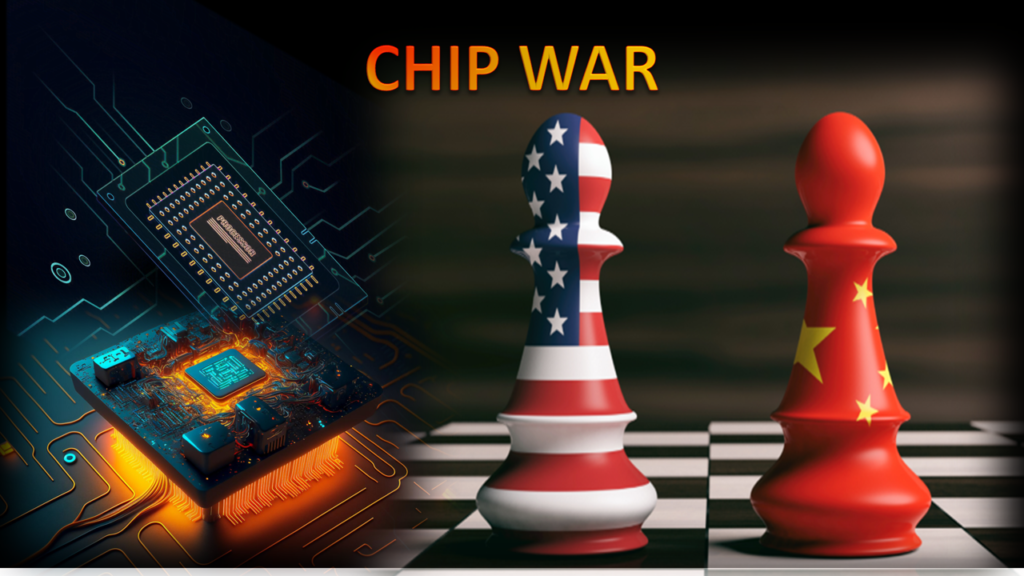ABC of Chip War – Part III – Geopolitics and Chips: If technology is the domain of competition in great power rivalry or the ‘new cold war’; chip is the center of gravity. There is no technological progress without electronics and there is no electronics without chips. ABC of Chip War – Part III – Geopolitics and Chips will focus on the relationship of great power competition and chips.
ABC of Chip War: Weaponized Interdependence
Self reliance is commonly used term in national security circles. Reliance is exploitable and at best dependent on the good will of the party relied upon. Globalization is interdependent. In today’s world Perry does not have to sail to Japan for a forced opening.
Thomas J. Wright in his book, All Measures Short of War, asserts that it is a world where interdependence is combined with continuous power struggle. Thus avoiding direct conflict, states have options of measures short of war.
Henry Farrell and Abraham Newman, have observed that states with political authority over the
central nodes in the international networked structures for money, goods, and information travel can impose costs on others. This leveraging of unique status is what they have termed as ‘weaponized interdependence‘.
Although this phenomenon is not new. For instance, Continental System of Napoleon was designed to paralyze U.K. economy and trade with the continent. However, globalized world offers far greater opportunities for weaponized interdependence.
China has been manufacturing powerhouse since many decades now. Chinese industry is ever more reliant on chips. So much that Chinese chip imports exceed the bill for crude oil imported. The Observatory of Economics Complexity notes that China was the second largest importer of semiconductor devices in 2021 costing 13.4 billion USD. First was Hong Kong, which many will read as mainland China, which imported semiconductor devices worth 18.9 billion USD.
Chinese military has become more ‘informationized’ and ‘intelligentized’, her national security is also at risk. In 1980s, Jerry Sanders, founder of AMD, noted that semiconductors are like crude oil, whoever controls them will control the electronics industry. Chips are more strategic than oil as its evolution has indicated.
As highlighted earlier, U.S. and her allies control chip industry with two caveats though. One ‘fabs’ as they are fashionably called are concentrated in East Asia. Second, China is likely to gain further market share while U.S. share is likely to decrease as per projections.
For instance, semiconductors.org statistics indicate 1 percent YoY decline for U.S. in global chip design share reducing from 46 percent in 2020 to 36 percent by 2030. In the same period, Chinese share is projected to rise from 9 percent in 2020 to 23 percent in 2030.
In addition many countries consider chip industry as critical. U.S. has enacted Chips and Science Act which aims to spend 13 billion USD on chip R&D alone. The CHIPS and Science Act also placed 2 billion USD toward the Chips Defense fund, which will supplement DoD’s National Network for Microelectronics R&D.
Similarly, on 25 July 2023 E.U. has adopted ‘E.U. Chip Act’ which includes up to 43 billion USD
in targeted support for Europe’s semiconductor sector. South Korea in 2021 unveiled the “K-Semiconductor Belt” strategy to build world’s largest semiconductor supply chain by 2030. Japan approved $6.8 billion for domestic semiconductor investment as a part of its goal to double domestic chip revenue by 2030. In November 2022, Japan proposed an additional $8 billion in funding for a joint research hub with the United States. India rolled out a $10 billion semiconductor incentive package in December 2021. While, Taiwan, Vietnam, Thailand, Mexico and Canada are contemplating tax and other incentives to attract investments in chip industry. China, of course has also doubled down on investments to boost chip industry.
Net result is more likely to be a balanced spread of economic dividends. However, for U.S. chip industry risk of Chinese domination like so many other fields cannot be ruled out specially when silicon valley has a historical precedence of ‘economic war’ with Japan.
ABC of Chip War: Chip War of 80s
After receiving a gift of Sony transistor radio in 1962 from Japanese prime minister Hayato Ikeda, Charles De Gaulle declared Japan as nothing but an ‘economic power’ and Ikeda a ‘transistor salesman’. Post WW II, U.S. supported Japanese rise as a ‘transistor salesman’.
Washington realized that ‘ a strong Japan is better risk than a weak Japan’. Therefore, U.S. government supported Japan’s rebirth as a technological and scientific power. This policy however had technological as well as economic downside. This came to full swing in 1980s.
Before 1970s, device called magnetic core functioned as memory for computers. It was a matrix of metal rings joined through wires. Magnetized ring stored 1 and non-magnetized stored 0 for the computer. But as demand for memory was exploding this ring and wire device was neither efficient nor compact; alternate was what came to be known as Dynamic Random Access Memory (DRAM).
It was a chip. Intel launched it and planned to dominate the business of memory chips. U.S. companies like Intel and AMD were also dominant players in logic chips.
By 1980s, however, U.S. firms like Intel and Texas Instruments were facing cutthroat competition from Japanese firms like Toshiba and NEC in DRAM business.
Hewlett-Packard in 1980s found that Japanese DRAMs were superior in quality with failure rates around 0.02 percent. Their American counterparts were producing DRAMs with 0.09 percent failure rates. Which implies that American chips were failing four and a half times more.
By 1980s, as Japan mastered mass production, Japanese firms developed into ‘innovators’ rather than ‘implementers’. Sony became synonymous to consumer electronics. Sony’s Walkman, with 5 of its own designed and developed cutting edge ICs, revolutionized music industry in 1979 as Apple’s iPod did in 2001. Sony sold 385 million units, making Walkman one of the most popular consumer product.
In 1978, GCA Corp that produced chip scanners for photolithography machines, developed a device called ‘stepper’ that brought efficiency in chip production. Company’s share price surged as revenue of the company increased from 50 million USD to 300 million that year.
By 1981 GCA Corporation was the hottest high tech firm in U.S. Initially it bought lenses from Japanese firm Nikon. However, GCA later switched to a local firm Tropel. Nikon meanwhile bought a Stepper, reversed engineered it and soon was producing its own.
With better quality and customer service, efficient mass production and government’s support for R&D through programs like Very Large Scale Integrated Semiconductor Project (VLSI), Nikon soon gained substantial market share. In 1978, U.S. firms led by GCA Corp held 85 percent of lithography machines market share. By 1988 it dropped to 50 percent.
Decline of GCA became a common example in debate on Japanese rise and America’s decline. with leading economists blaming poor job structures, lamenting paper entrepreneurship in Silicon Valley and warning of foundering STEM programs in American educational system.
Yet U.S. chip industry maintained that Japan’s firms committed intellectual property theft, benefitting from protected markets, government subsidies, and availability of low interest capital. This did not deter Japanese firms. By the end of 1980s Japan was producing 70 percent of lithography machines for the world. While U.S. share declined to 21 percent.
Chip War of 80s: U.S. Mitigation Failure
In 1980s U.S. DoD recruited semiconductor industries luminaries to compile a report on how to revitalize American semiconductor industry. Report summarized that U.S. forces depended heavily on technological superiority.
Declaring electronics as key technology, it asserted that soon U.S. defense will be dependent upon foreign sources for state-of-the-art technology in semiconductors. When U.S. forces demonstrated precise air power in Gulf War in 1992; Japanese firms asserted that it was possible because of Japanese patents. They were correct to a greater extent.
As Japanese advantage in chip industry grew, Silicon Valley started lobbying in Washington. Along with Pentagon’s prodding they were able to convince Washington to gradually undertake measures to check Japanese rise. Japan by now was the second largest economy in the world.
First the U.S. Government reduced taxes and amended financial regulations that allowed more capital inflow. Semiconductor Chip Protection Act (SCPA) was enacted in 1984 to address intellectual property protection. It was basically a integrated circuit layout design protection act. U.S. and Japan also reached an agreement to eliminate tariffs on semiconductor trade, however, yet U.S. struggled to sell more chips in Japan.
These measures were not enough. Reagan administration finally decided to act and threatened tariffs. With this threat looming, in 1986 Japan agreed to put quotas on its exports of DRAMs. Despite these, U.S. decline in semiconductor industry continued.
It was innovation and far reaching decisions made by industry itself that revived its position. Innovations in development of PCs, Internet, Smart Phones as well as software development that the computing power used enabled U.S. resurgence.
Japanese companies though had the bitter experience when due economic crises of 90s, cheap capital was no more available. In addition, their entrepreneurs failed on many instances to pursue a cutting edge technology. For instance, Toshiba thought that EUV lithography was not possible.
Here is the lesson that highlight the importance of innovation especially in tech industry. Those who could not keep up with the Moore’s law did not survive.
To be continued.






